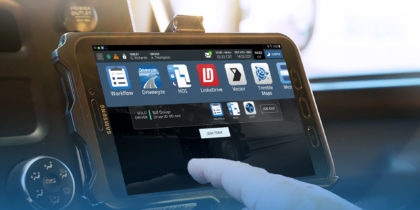The world as we know it is changing at a rapid clip. Businesses are transitioning to digital platforms and more often than not, technology is now at the center of how we connect and communicate with each other professionally and personally. To get a better sense of what the digital future might look like, Samsung Business Insights sat down with futurist and AR/VR consultant Charlie Fink in our Business Disrupted podcast, Episode 5: The Business Benefits of Virtual Reality and Augmented Reality.
Q: How are technologies like artificial intelligence (AI), virtual reality (VR) and augmented reality (AR) going to change mobile devices?
Fink: This is the internet in 1995. In two years, people are going to be looking at the world very differently because the camera will be the primary interface on the phone, not the app and not the screen in your lap. It’s going to dramatically change the way people do mobile computing.
When we get into AR glasses, sound is going to matter a lot more than optics and be operated by artificial intelligence. Let me give you an example: You’re wearing a pair of AR glasses and you’re at a conference where you have social media turned on so it will identify people who are in your social graph. Would you like their profile to just pop up in your field of view or would you rather have a little icon appear next to them and have the AI whisper in your ear who they are?
Q: The marriage of AI and VR/AR is interesting, especially in use cases beyond gaming. On that note, what are some use cases for a virtual reality application on the business side that you are seeing?
Fink: What we’re seeing is a lot of AR and VR being used in enterprise applications. Of course, that’s somewhat invisible to most observers because it’s not quantified through sales, but through savings. There are hundreds of use cases of companies using both AR and VR to save money in training and in manufacturing. I think these use cases are becoming more and more well known as the giant consulting companies begin to push these solutions. Because that’s where change comes from — inside of Fortune 500 companies.
Q: For companies that lack the resources of a Fortune 500, but want to enact digital transformation in the workplace including a virtual reality application, how do they get started?
Fink: I would say the best way for a midsize company to start experimenting with some of these technologies is to use them in concert with the technologies they’re already using. If you have an app or a website, for example, you can make it better and increase your engagement with the user, whether it’s a customer or internal, by adding VR or AR. That’s a very economical way to start using the technology without changing everything.
Listen to the Podcast
Hear more insights from Charlie Fink, appliedVR President Josh Sackman and more. Download Now
Q: What industries do you think will be the most disrupted by these technologies?
Fink: The manufacturing process is going to be severely disrupted in 20 years. It will look very different than it does today. You might 3D print every single component you need for a car and assemble it locally and never have to ship a car.
Q: Do you have advice for those in manufacturing or other industries that are facing this kind of disruption from these technologies?
Fink: The first step starts with developing expertise. The second step is developing the approach of a futurist and not thinking three years or even five years out as most companies do. I think that most forward-looking companies are thinking at 20 or 30 years out. I think companies in China are thinking that far out, and companies that don’t think that way will be at a disadvantage.
Change occurs very slowly until it happens all at once. If you want to talk 20 years out, that’s the scale and the disruption I see. I think society is going to be very different in large industrialized countries like ours.
Q: How do you think VR and AR technology will change the way we do business or interact with each other in the future?
Fink: The most transformative thing that’s going to happen is volumetric telepresence — in terms of how we interact both in the workplace and interpersonally. Our homes are going to be filled with 3D cameras so that my children in California, assuming that they are wearing a VR headset, could be volumetrically present in my house across the country. I think that’s going to be pretty freaking dramatic.
For more insights from Charlie Fink as well as Josh Sackman, president of appliedVR, and Keith Curtin, VP of business development at Zappar and founder at See Digital, tune into Samsung’s Business Disrupted podcast, Episode 5: The Business Benefits of Virtual Reality and Augmented Reality.








